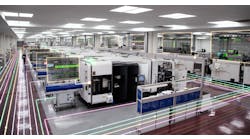Editor’s Note: The following case study involves a waterjet propulsion systems manufacturer in New Zealand, but the experiences and lessons learned are applicable to American manufacturers and machine shops. The company has been using Mastercam since 1990, and has learned that staying current with the latest releases improves productivity and profitability.
CWF Hamilton & Co. in Christchurch, New Zealand, manufactures HamiltonJet waterjet propulsion systems that give a boat tremendous maneuvering capabilities while allowing it to travel in shallow water areas.
These drives also are important for military applications, allowing troops to be offloaded within feet of a shoreline.
Since 1954, HamiltonJet has worked with vessel designers and builders to create waterjet propulsion systems that deliver high performance and efficiency. The company pioneered the development of the modern waterjet more than 50 years ago, and they continue to develop innovations today.
Hamilton is known for creating superior waterjet propulsion systems for commercial applications, workboats, patrol, military craft, and pleasure boats.
Today, waterjets are the preferred propulsion choice where high-speed efficiency, outstanding maneuverability, shallow draft capability, and low maintenance are needed.
HamiltonJet’s waterjet propulsion systems range includes models for power inputs from 150 kW to 3,000 kW, for vessels typically up to 60 meters (197 ft.) long. All models include features such as integral intake and transition duct for easy installation, as well as steering and reverse components. All but the smallest units include fully integrated hydraulic reverse systems with jetdriven hydraulic pumps, control valves, and an oil-cooler that is cast into the waterjet intake.
Building these complex waterjets isn’t easy.
Many of the parts start out as castings and have to be turned or milled. Often, shaft work requires the use of a five-axis turning center to produce the many machined features efficiently.
Machining these various complex features presents challenges, such as the complex toolpaths that a five-axis machine tool must follow.
Mike Neville, senior programmer with the company, notes that the company has turned to Mastercam X2 Mill Level 3, Lathe, Multiaxis, and Solids software (from CNC Software Inc., Tolland, Conn.) to meet these challenges. With robust business growth resulting from successful products, the company now has more than 300 employees in a 10,000 sq. m.(107,600 sq. ft.) factory, and has gone from having one Mastercam programmer to five full-time machine tool programmers.
HamiltonJet produces a range of 15 waterjet units.
“We have castings of the primary outer parts of the unit along with main shafts, couplings, and other internal components. These components all require machining processes,” Neville said.
“Many of these parts for our small HJ Series Waterjet drive have a 200mm to 400mm (7.87 in. to 15.75 in.) diameter impeller. To machine these parts we mount them on tombstones, and they are machined on one of our three twin-pallet HMC milling centers or on our fourth center that has a six-pallet changer.
“For our larger HM Series jet drive, we have seven models ranging in impeller diameters from 420mm to 810mm (16.54 in. to 31.9 in.). We are also working on a new larger series of waterjets that will go up to 1100mm (43.3 in.)diameter impellers,” he added.
When Neville first started with the company, they were doing their toolpath programming right at the machine, using paper tape, pen, and paper.
“It was going back to the dark ages. Mastercam version 4.11 was supplied to us when we bought our first horizontal CNC machining center in 1990. As the company grew, we started to use the software a lot more. We used different post processors to modify Mastercam for different machine tools from multitasking machines to a multiaxis lathe and two-axis lathes. Mastercam handles everything that we throw at it. It allows us to get programmers who are using it trained and programming relatively quickly,” Neville said.
“We looked at other toolpath software through the years, but we never went much further than testing it, because Mastercam works so well and we’ve grown with it. And we’ve developed some specific post processors for our lathe software that work extremely well for our applications,” he added.
Today, the company uses four fiveaxis lathes, and Neville said he believes it would be nearly impossible to keep all the cutting areas under control without a CAM program.
Difficult part machining made easier with Mastercam
Castings that house the internal waterjet drive parts aren’t that difficult to machine, Neville noted.
The trickiest parts are the main shafts for jet drives, whichrequire a lot of different operations for their various features. They include different diameters on the main shaft, threads, splines and tapered keyways and, to machine them, the company uses five-axis mill/turn lathes, that allow all the operations to be completed on one machine.
“Mastercam really shines for this type of machining,” Neville said.
“It used to take up to 45 minutes to machine a keyway on the shaft. By using Mastercam and streamlining the toolpath, I was able to get the machining down to 11 minutes. These machines are also time critical. We don’t have much time to spare on them, so by reducing machining times, it helps us put through more product. [Mastercam’s] Verify feature has also helped us to make sure the new toolpath would do what we wanted it to do and to speed production up. Mastercam saves a lot of time on our machine tools because of its capabilities,” he added.
Smaller diameter impellers that are used as the driving element for the waterjet are cast in one piece. Larger ones are currently fabricated, meaning that they cast the hub and the blades separately, and then weld the blades to the hub.
The process is being changed, however, to allow for one-piece impellers in the larger jet ranges. These are machined in a secondary operation, but they aren’t machined from a solid.
According to Neville, machining these parts from a solid would be unproductive because of the impeller’s design.
Lathe operations for these parts are simple, he said; just boring and turning. However, at times there mill/turn work is required, such as the need to mill the O.D. or to trim the impellers to suit specific power requirements. The shop uses Mastercam to program all the toolpaths for the impellers.
“I’ve found that the new Mastercam interface for Windows (introduced in Mastercam X) is a lot more productive and easier to use. I really like the operations manager in it. I think one of the best things that I like about Mastercam is how easy it is to be trained on it and having an operator using it after only a day’s worth of training. It’s also easy to produce post processors for it. We have a wide range of machine tools, so we need a wide range of post processors for them,” Neville said.
Hamilton’s HJ Series of waterjets has eight models that use impellers that range in diameter from 215mm to 391mm (8.5 in. to 15.4 in.) for watercraft that range from 6 m to 20 m (19.7 ft. to 65.6 ft.).
HamiltonJet also designs and manufactures hydraulic and electronic control components for all of its waterjet models. Its electronic control systems can integrate with a range of other vessel systems, such as engine and gearbox controls, autopilot, voyage data recorders, and dynamic positioning systems to provide complete vessel maneuvering control.






